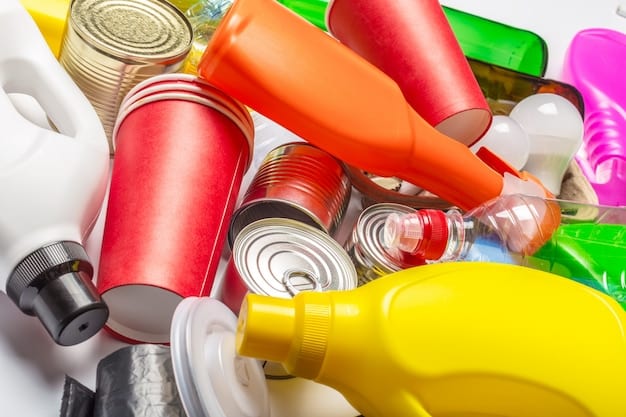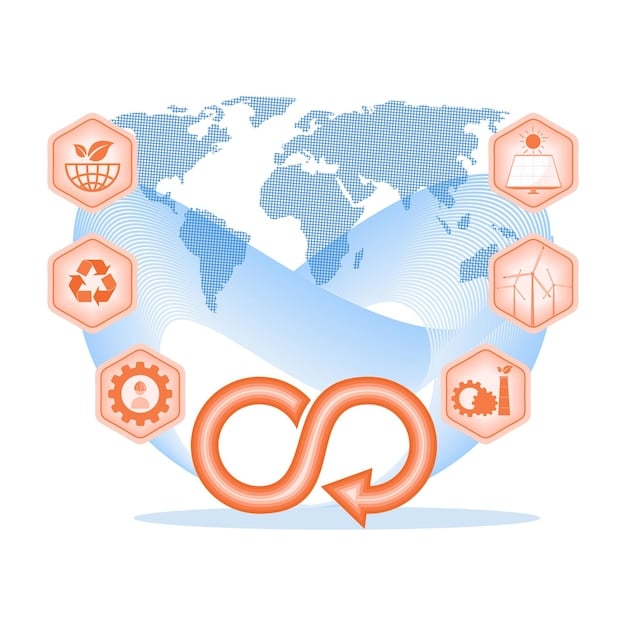Boosting US Recycling: The Science to Reduce Landfill Waste

Advertisements
Improving recycling rates and reducing landfill waste in the US requires a multi-faceted scientific approach, leveraging advanced material sorting, public education, policy innovation, and economic incentives to transform waste management practices.
Advertisements
The journey towards a sustainable future in the United States hinges significantly on our relationship with waste. While recycling has become a familiar concept, truly understanding the science of recycling: how can we improve recycling rates and reduce landfill waste in the US? is paramount to overcoming existing challenges and forging a more circular economy.
Unpacking the Current State of Recycling in the US
The vast landscape of waste management in the United States is a complex tapestry woven with varying local policies, economic drivers, and public participation levels. Despite widespread awareness, the nation’s recycling rate lags behind many developed countries. This disparity points to systemic issues that require a more granular examination, moving beyond superficial assumptions to understand the deep-rooted scientific and logistical hurdles.
Advertisements
A significant portion of what could be recycled still ends up in landfills, consuming valuable space and contributing to greenhouse gas emissions. This isn’t merely an issue of individual habits; it’s a reflection of an intricate system that often struggles with infrastructure, market demand for recycled materials, and an inherent lack of standardization across different municipalities. The science here isn’t just about material properties but also about economic and behavioral science.
Challenges in the US Recycling Infrastructure
One of the primary roadblocks to higher recycling rates is the fragmented and often outdated recycling infrastructure. Many facilities struggle with efficient sorting and processing, particularly with the increasing complexity of modern packaging materials. The quality of recycled feedstock can be compromised, making it less attractive to manufacturers compared to virgin materials.
- Contamination of recyclables due to improper sorting by consumers.
- Outdated material recovery facilities (MRFs) unable to process diverse waste streams.
- Lack of standardized recycling guidelines leading to confusion among residents.
- Limited domestic markets for certain recycled materials, leading to stockpiling or landfilling.
Furthermore, the economics of recycling are profoundly influenced by global commodity markets. When virgin material prices are low, the incentive for manufacturers to use recycled content diminishes, creating a bottleneck in the recycling loop. This economic volatility adds another layer of complexity to an already challenging system, demanding intelligent policy interventions and market innovations to stabilize demand.
Addressing these foundational issues requires an integrated approach that combines technological advancements with policy reforms. It’s about building a resilient system that can adapt to changing waste streams and market conditions, ensuring that the resources we recover are seamlessly re-integrated into the economy. The scientific principles of material flow analysis and life cycle assessment are crucial here to identify bottlenecks and optimize the entire process.
Advanced Sorting and Processing Technologies
The future of recycling lies significantly in the adoption and scaling of advanced sorting and processing technologies. These innovations are designed to overcome the limitations of traditional methods, improving the purity and value of recycled materials, which in turn boosts market demand and overall recycling efficiency. This technological leap represents a pivotal shift in how we approach waste, moving from a linear system to a truly circular one.
Material Recovery Facilities (MRFs) are at the forefront of this transformation. Traditional MRFs rely heavily on manual labor and basic mechanical sorting. Modern and future MRFs, however, integrate cutting-edge technologies that can identify and separate materials with unprecedented precision, enhancing the quality of the recycled output.
Optical Sorters and Robotics
Optical sorters use infrared light to identify different types of plastics, papers, and other materials based on their unique spectral signatures. This allows for highly accurate separation, even for commingled streams. Robotic sorters, equipped with artificial intelligence and machine learning algorithms, can perform complex picking tasks at high speeds, adapting to diverse shapes and sizes of materials.
- Identifies material types with high accuracy, reducing contamination.
- Processes large volumes of waste quickly and efficiently.
- Reduces the need for manual sorting, improving safety and consistency.
- Adapts to new packaging materials through software updates.
These systems are not just about speed; they are about precision. By delivering cleaner, more consistent streams of recycled materials, they make these materials more attractive to manufacturers who demand high-quality inputs for their production processes. The scientific basis for these technologies lies in material spectroscopy and advanced robotics, driving efficiency and effectiveness.
Chemical Recycling and Pyrolysis
Beyond mechanical sorting, chemical recycling methods offer a promising solution for hard-to-recycle plastics that currently end up in landfills or are incinerated. Processes like pyrolysis break down plastics into their basic chemical components, which can then be used to create new plastics or fuels. This is particularly valuable for mixed or contaminated plastics that cannot be mechanically recycled.
While still in their early stages of commercial development, these technologies hold significant potential to expand the range of materials that can be recycled, transforming waste into valuable resources. The scientific challenges here involve optimizing the chemical reactions for different plastic types and ensuring the economic viability and environmental sustainability of these processes. Developing these capabilities domestically can also create new industries and jobs.
Policy and Economic Incentives for Circularity
Technological advancements alone are insufficient to dramatically improve recycling rates without robust policy frameworks and economic incentives that drive systemic change. Governments at all levels, alongside industry and consumers, must collaborate to create an environment where recycling is not just an option but a default, economically viable, and socially imperative practice. This involves a shift from a linear “take-make-dispose” model to a circular economy where resources are continually reused.
Effective policy can correct market failures, internalize environmental costs, and stimulate demand for recycled content. Without clear signals from policymakers, businesses may not invest in the necessary infrastructure or adapt their production processes to incorporate more recycled materials, thereby stifling the growth of the recycling industry.
Extended Producer Responsibility (EPR)
Extended Producer Responsibility (EPR) programs hold manufacturers accountable for the entire lifecycle of their products, from design to end-of-life. By shifting the financial and operational burden of waste management from municipalities to producers, EPR encourages companies to design products that are more durable, repairable, and recyclable. This pushes innovation towards more sustainable packaging and product design.
- Encourages manufacturers to design products for recyclability.
- Provides a stable funding source for recycling infrastructure.
- Reduces financial burden on local governments for waste management.
- Fosters a sense of shared responsibility across the supply chain.
Such policies have been successful in many European countries, significantly increasing their recycling rates. Implementing comprehensive EPR schemes in the US would require careful consideration of existing regulations, industry capabilities, and consumer behavior, ensuring a smooth transition and equitable distribution of responsibilities across the value chain. The economic science behind these models focuses on incentivizing desirable behaviors.
Beyond EPR, other economic incentives such as grants for recycling infrastructure, tax breaks for businesses using recycled content, and carbon credits for waste diversion can further accelerate the transition to a circular economy. These financial mechanisms make recycling more economically attractive and competitive with the use of virgin materials, bridging the price gap that often hinders market demand for recycled products. They are crucial for de-risking investments in the recycling sector and fostering innovation.
The Crucial Role of Public Education and Engagement
No matter how advanced the technology or how robust the policies, the success of recycling initiatives ultimately hinges on informed and engaged public participation. Confused consumers are often a major source of contamination in recycling streams, leading to rejection of entire batches of otherwise recyclable materials. Therefore, comprehensive, consistent, and clear public education is indispensable for improving recycling rates and reducing landfill waste.
Many people want to do the right thing, but the sheer variety of recycling rules across different communities in the US can be overwhelming. What’s recyclable in one county might not be in another, leading to the phenomenon known as “wishcycling,” where non-recyclable items are placed in recycling bins in the hope they can be processed. This goodwill, unfortunately, often does more harm than good.
Standardizing Recycling Messaging
One of the most impactful steps to improve public engagement is the standardization of recycling labels and guidelines across the nation wherever feasible. A unified system, easily recognizable and understandable, would significantly reduce confusion. The ‘How2Recycle’ label, for instance, offers clear instructions and is gaining traction, but broader adoption is needed.
- Clear, visual guidelines on what can and cannot be recycled.
- Accessible information through multiple channels (online, print, community events).
- Emphasis on the ‘why’ of recycling, highlighting environmental and economic benefits.
- Interactive tools and apps to help residents identify recyclable items.
Beyond simple labels, public education campaigns should be dynamic and ongoing, utilizing various media to reach diverse demographics. These campaigns should provide specific, actionable advice, rather than generic calls to “recycle more.” They should also address common misconceptions and provide feedback on the impact of local recycling efforts, fostering a sense of community achievement and collective responsibility.
Moreover, engaging with younger generations through school programs can instill lifelong recycling habits and environmental stewardship. By embedding circular economy principles into educational curricula, we can cultivate a future generation that inherently understands and practices sustainable resource management. The behavioral science here suggests that early exposure and consistent reinforcement lead to durable changes in habits.

Innovations in Waste Stream Diversion and Reuse
While recycling is a critical component, true waste reduction goes beyond merely processing discarded materials. It encompasses a broader strategy of waste stream diversion and emphasizes reuse, repair, and redesign at the product level. This holistic approach aims to prevent waste from being generated in the first place, or to find alternative uses for materials that might otherwise be destined for landfills. The scientific principles governing material flows, product design, and ecological systems are central to these innovations.
The concept of a circular economy extends beyond just recycling; it is about designing out waste and pollution, keeping products and materials in use, and regenerating natural systems. This requires a fundamental shift in how products are conceived, manufactured, consumed, and ultimately managed at their end-of-life.
Embracing Redesign and Repair Culture
One of the most effective ways to reduce landfill waste is to design products for longevity, repairability, and eventual reuse or easy disassembly for recycling. This contrasts sharply with the prevailing linear model of planned obsolescence. Companies that embrace “design for environment” principles consider material choices, product structure, and end-of-life options during the initial design phase.
- Modular product designs that allow for easy component replacement.
- Universal repair guides and accessible spare parts for consumers.
- Incentives for businesses to offer repair services rather than replacement.
- Development of durable, high-quality alternatives to single-use items.
Furthermore, fostering a robust repair culture can significantly extend product lifespans. Repair cafes, community workshops, and accessible professional repair services can empower consumers to fix items rather than discard them. This not only reduces waste but also creates local economic opportunities and fosters a sense of community resilience, minimizing the carbon footprint associated with new production. The economic implications include job creation in maintenance and repair sectors.
Innovations in packaging also play a crucial role. Shifting from single-use plastics to compostable alternatives, reusable containers, or even completely eliminating unnecessary packaging can drastically reduce waste volumes. Companies are exploring refill and return schemes that keep packaging materials circulating within the supply chain, moving away from resource-intensive single-use models. This requires materials science expertise to develop packaging that is both functional and environmentally benign.
Addressing Hard-to-Recycle Waste Streams
A significant portion of landfill waste in the US consists of items that are technically recyclable but are challenging to process using conventional methods due to their composition, contamination, or economic viability. These “hard-to-recycle” waste streams include multi-layered packaging, certain types of rigid plastics, electronics (e-waste), and textiles. Tackling these streams is crucial for making substantial inroads into landfill reduction. The science here spans material engineering, chemistry, and logistics.
Conventional mechanical recycling often struggles with mixed materials, composite products, or items containing hazardous components. This limitation highlights the need for specialized collection, processing, and innovative technologies that can effectively handle these complex waste streams, unlocking their inherent material value.
Revolutionizing E-Waste and Textile Recycling
E-waste, or electronic waste, is the fastest-growing waste stream globally, laden with valuable metals and hazardous substances. While some components are easily recycled, the intricate nature of modern electronics makes comprehensive recycling difficult. Advanced e-waste recycling involves sophisticated shredding, magnetic separation, and chemical leaching to recover precious metals while safely managing toxic elements.
- Specialized collection points and take-back programs for electronics.
- Development of urban mining techniques to recover rare earth elements.
- Research into modular electronics for easier disassembly and recycling.
- Consumer education on the importance of proper e-waste disposal.
Textile waste also presents a massive challenge, with fast fashion contributing to huge volumes of discarded clothing that often ends up in landfills. Innovations in textile recycling include fiber-to-fiber recycling processes that break down fabrics to their molecular level to create new yarns, and sorting technologies that can identify different fiber compositions. This helps reduce reliance on virgin materials and minimizes the environmental footprint of the fashion industry.
For multi-layered packaging, which combines different materials (e.g., plastic and aluminum) to enhance product shelf-life, delamination technologies are under development to separate these layers for individual recycling. While still economically challenging, these processes are vital for achieving circularity for a vast array of consumer products. Continued investment in research and development for these challenging waste streams will be critical for future improvements in overall recycling rates across the board.

Community Engagement and Local Initiatives
While national policies and technological advancements provide the overarching framework, the tangible impact on recycling rates often happens at the local level through dedicated community engagement and grassroots initiatives. Strong local programs can bridge the gap between systemic goals and individual actions, fostering a sense of ownership and collective responsibility for waste management. This localized approach recognizes that communities have unique challenges and opportunities, requiring tailored solutions.
Effective community engagement goes beyond simply providing recycling bins; it involves active participation, education customized to local needs, and creating convenient access points for hard-to-recycle items. It’s about making recycling an integral and easy part of daily life, rather than an afterthought or a complex chore.
Drop-Off Centers and Special Collections
Many communities have enhanced their recycling efforts by establishing convenient drop-off centers for materials not typically collected curbside, such as electronics, hazardous waste, and textiles. These centers often serve as valuable educational hubs, providing residents with resources and information on waste reduction strategies.
- Designated collection events for hazardous waste (e.g., paint, batteries, chemicals).
- Partnerships with local businesses for specialized recycling of specific items.
- Community-led composting initiatives for organic waste diversion.
- Mobile recycling units that visit different neighborhoods on a schedule.
Moreover, local initiatives can pilot innovative programs like zero-waste challenges, repair workshops, or material swap events that encourage reuse and reduce consumption. These small-scale successes can then inform larger municipal policies and inspire wider adoption, creating a ripple effect across the community. The scientific insights from urban planning and social psychology are crucial for designing these effective community programs.
Furthermore, leveraging digital platforms and social media for hyper-local communication can significantly boost participation. Targeted campaigns addressing local contamination issues or promoting specific recycling events can be highly effective. Creating a feedback loop where residents see the positive impact of their efforts can reinforce good habits and foster a stronger recycling ethic within the community, making the transition to a more circular economy a shared endeavor.
| Key Area | Brief Description |
|---|---|
| 🔬 Advanced Tech | Leveraging optical sorters and robotics for purer recycled materials. |
| ⚙️ Policy & Economy | Implementing EPR schemes and economic incentives for circularity. |
| 🗣️ Public Engagement | Standardizing messaging and enhancing community education for compliance. |
| 🔄 Waste Diversion | Innovating in reuse, repair, and addressing hard-to-recycle streams. |
Frequently Asked Questions About US Recycling
Wishcycling refers to placing non-recyclable items into recycling bins with the hope they can be recycled. This practice is problematic because it contaminates the recycling stream, making the sorting process more difficult and costly. Contaminated batches may even be rejected and sent to landfills, undermining genuine recycling efforts and increasing operational inefficiencies at recycling facilities.
EPR shifts the financial and operational responsibility for the end-of-life management of products to manufacturers. This incentivizes companies to design products that are more durable, repairable, and easily recyclable. By making producers accountable, EPR programs provide a stable funding source for recycling infrastructure and reduce the burden on municipal waste management systems.
Technology, such as optical sorters, robotics, and chemical recycling, plays a crucial role in improving recycling rates by enhancing the efficiency and purity of sorted materials. These advanced systems can identify and separate different types of plastics and other materials with high precision, making them more valuable to manufacturers and allowing for the recycling of previously unrecyclable items.
Public education is essential because an informed public reduces contamination in recycling streams and increases participation. Clear, consistent messaging on what to recycle and how to prepare it helps overcome confusion caused by varying local rules. Educated citizens are more likely to comply with guidelines, leading to higher quality recycled materials and more efficient recycling operations.
Beyond recycling, strategies like reuse, repair, and redesign are vital for reducing landfill waste. Promoting modular product design, offering repair services, and encouraging the use of reusable containers minimize waste generation at the source. Composting organic waste and developing markets for hard-to-recycle materials also divert significant volumes from landfills, fostering a more circular economy.
Conclusion
The imperative to boost recycling rates and substantially reduce landfill waste in the US demands a multi-pronged, scientifically informed approach. It’s a complex challenge that requires more than just individual effort; it calls for a systemic overhaul driven by technological innovation, robust policy frameworks, and sustained economic incentives. Furthermore, comprehensive public education campaigns, coupled with localized community initiatives, are essential to foster collective responsibility and ensure consistent adherence to best practices. By embracing advanced sorting technologies, shifting to extended producer responsibility, and nurturing a culture of reuse and repair, the United States can transition from a linear waste model to a resilient, circular economy that maximizes resource recovery and safeguards our environmental future.





